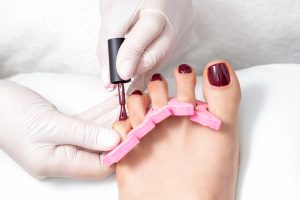7 Things Doctors Tell Their Friends About Feet
Source: Redbook
Top docs weigh in on everything from scary pedicures to stinky feet.
If you forgot to corner the podiatrist at the last party you went to, don’t worry. These top docs share their surprising insights into how to stay healthy from your head down to your—well, you know.
ANYONE CAN GET A STRESS FRACTURE
 “Last spring, a woman I know went to New York City for vacation. She walked everywhere, and when she came back, she was in a lot of pain. To her surprise, she had a stress fracture. I didn’t find it shocking at all: Most people think stress fractures only happen to runners who pound the pavement regularly, but they can actually be caused by any kind of repetitive movement, especially if it’s a sudden uptick in exercise. I told her to ask her primary care doctor for a bone density test, and make sure she was getting enough vitamin D and calcium— women who are losing bone mass are at higher risk for stress fractures. Then, it was a matter of resting her foot for four to six weeks and making sure she wore hard-soled shoes for support. An X-ray showed she had finally healed— and she told me she’d definitely take more taxis the next time around!” —Casey Humbyrd, M.D., assistant professor of orthopedic surgery at Johns Hopkins University School of Medicine in Baltimore
“Last spring, a woman I know went to New York City for vacation. She walked everywhere, and when she came back, she was in a lot of pain. To her surprise, she had a stress fracture. I didn’t find it shocking at all: Most people think stress fractures only happen to runners who pound the pavement regularly, but they can actually be caused by any kind of repetitive movement, especially if it’s a sudden uptick in exercise. I told her to ask her primary care doctor for a bone density test, and make sure she was getting enough vitamin D and calcium— women who are losing bone mass are at higher risk for stress fractures. Then, it was a matter of resting her foot for four to six weeks and making sure she wore hard-soled shoes for support. An X-ray showed she had finally healed— and she told me she’d definitely take more taxis the next time around!” —Casey Humbyrd, M.D., assistant professor of orthopedic surgery at Johns Hopkins University School of Medicine in Baltimore
BE CAREFUL WHEN YOU GET A PEDICURE

“It’s true that you can get an infection from the nail salon. Some are serious, others aren’t, but many can be prevented. I tell my friends to limit their risk by taking their own nail file and polish anytime they go for a pedicure. Why? Salon tools can carry germs, especially the emery board, which can’t be sanitized. And while it’s unlikely that bacteria or fungi could grow in a bottle of polish, don’t forget that the brush is used on other people’s toes: What if one of them has a fungal infection, or the brush is exposed to their blood through a small cut? It’s worth being careful—and remember, if you bring your own polish, you’ll always be satisfied with the color!” —Emily A. Cook, D.P.M., instructor in surgery at Harvard Medical School and director of podiatric medicine and surgery residency at Mount Auburn Hospital in Cambridge, MA
YOU CAN WEAR HIGH HEELS

“Women ask me all the time if high heels are bad for their feet, and I tell them, ‘Not necessarily.’ If you’re heading to a party or a job where you’ll be sitting a lot, it’s fine to wear a two- to four-inch heel. It’s when you stand or walk in them all day that it becomes a problem. High heels put pressure on your Achilles tendon and may cause your feet, knees, and hips to become overworked—which can lead to posture and balance issues. Your feet also may not absorb shock as well when you’re wearing heels, which can be painful. So you should only stand in them for two hours, if possible. Then, when you get home, stretch out your Achilles tendons and run some cold water over your feet and legs for 10 to 15 minutes. It’ll soothe any pain you’re feeling. And if you just can’t resist dancing the night away in a pair of heels, choose a sturdy wedge to lower your risk of what I call a ‘Gloria Gaynor fracture.’ It’s hard to pay attention to your feet when you’re getting down to ‘I Will Survive,’ and you might twist an ankle.” —Rock G. Positano, D.P.M., M.P.H., director of nonsurgical foot and ankle service at the Hospital for Special Surgery in New York City
SMELLY FEET? THIS WILL HELP.
 “Friends sometimes come to me complaining of foot odor (we’ve all been there!). First, you have to understand why your feet smell: Your feet and hands contain more sweat glands than any other part of your body. And when your feet sweat, the perspiration mixes with the bacteria living in your socks or shoes, generating the odor. The trick I share with folks: Drop a black tea bag in a warm foot-bath and soak your feet for 30 minutes—it’ll reduce the bacteria on your feet and cut down on the smell.” —Lee S. Cohen, D.P.M., a sports podiatrist practicing in Philadelphia and podiatrist consultant to the Philadelphia Eagles
“Friends sometimes come to me complaining of foot odor (we’ve all been there!). First, you have to understand why your feet smell: Your feet and hands contain more sweat glands than any other part of your body. And when your feet sweat, the perspiration mixes with the bacteria living in your socks or shoes, generating the odor. The trick I share with folks: Drop a black tea bag in a warm foot-bath and soak your feet for 30 minutes—it’ll reduce the bacteria on your feet and cut down on the smell.” —Lee S. Cohen, D.P.M., a sports podiatrist practicing in Philadelphia and podiatrist consultant to the Philadelphia Eagles
TREAT YOUR BUNION THIS WAY

“A friend came to me recently with a painful bunion. She was worried she would need surgery, which can take up to eight weeks of recovery time—time she didn’t have. She asked if there was any other way to heal it and even prevent it from coming back. This is what I told her: A bunion is a long bone that forms on the joint at the base of your big toe, and it’s often the result of ill-fitting footwear or unstable feet. My friend, for example, has flat feet, the perfect breeding ground for bunions because they don’t bear weight as effectively. Your big toe can start to rub against the one next to it, causing a bunion to ‘swing out.’ So unfortunately, there’s not a lot my friend could have done to prevent hers. (People with high arches are usually fine, as long as they wear shoes that fit.) Since surgery—which shortens the bone—was off the table, I suggested a Bunion Bootie, a flexible splint that pulls your big toe out so it no longer rubs. Wearing that regularly will help soothe the pain, as will avoiding shoes that compress your toes. She’s following my advice and says she’s feeling much better.” —Emily Splichal, D.P.M., podiatrist and human movement specialist practicing in New York City, and author of Barefoot Strong
THAT SPOT COULD KILL YOU
 “No one ever thinks to check their feet for signs of skin cancer. I tell my friends, ‘Everyone thinks Bob Marley passed away from cancer of the liver and brain, but his cancer actually started as melanoma on his toe.’ That gets their attention. Melanoma of the foot, especially the bottom of your foot, is extremely deadly because it so often goes unnoticed—and every part of your body can be exposed to the sun. So see your derm annually for a skin check, and do a monthly self-check at home. Look closely at your feet, especially the bottoms, between your toes, and under your toenails. Take note of any dark spots or red, scaly, or pearly spots on your skin. On your nails, watch for dark streaks or lines, as well as any protrusion—skin cancer under a nail can make it jut out. See your doc if anything looks troubling. If you catch skin cancer early, it’s almost always curable.” —Will Kirby, D.O., board-certified dermatologist practicing in Los Angeles and associate clinical professor of dermatology at Nova Southeastern University and Western University of Health Sciences
“No one ever thinks to check their feet for signs of skin cancer. I tell my friends, ‘Everyone thinks Bob Marley passed away from cancer of the liver and brain, but his cancer actually started as melanoma on his toe.’ That gets their attention. Melanoma of the foot, especially the bottom of your foot, is extremely deadly because it so often goes unnoticed—and every part of your body can be exposed to the sun. So see your derm annually for a skin check, and do a monthly self-check at home. Look closely at your feet, especially the bottoms, between your toes, and under your toenails. Take note of any dark spots or red, scaly, or pearly spots on your skin. On your nails, watch for dark streaks or lines, as well as any protrusion—skin cancer under a nail can make it jut out. See your doc if anything looks troubling. If you catch skin cancer early, it’s almost always curable.” —Will Kirby, D.O., board-certified dermatologist practicing in Los Angeles and associate clinical professor of dermatology at Nova Southeastern University and Western University of Health Sciences
PAIN IN THE FEET CAN MEAN A PROBLEM SOMEWHERE ELSE

“A while back my brother-in-law started experiencing numbness and tingling in his feet. I told him to see his doctor right away because those symptoms, as well as burning, can indicate a range of conditions that can be truly serious. In his case, it was a compressed nerve in his back. That’s since been treated, and he’s doing well. But his symptoms also could have pointed to diabetes or peripheral vascular disease, where the arteries that run toward your feet are blocked. And they’re not the only symptoms that are worrisome: If both of your feet swell out of the blue, you could have an issue with your kidneys, causing fluid buildup. If one foot swells—especially if your foot or leg is red and painful—get help right away because you could have a blood clot. Dry, flaky, cold feet indicate thyroid trouble, too. My point is, don’t panic, but definitely don’t ignore these kinds of symptoms. See your doctor as soon as possible.” —Tara Narula, M.D., a medical contributor for CBS This Morning
